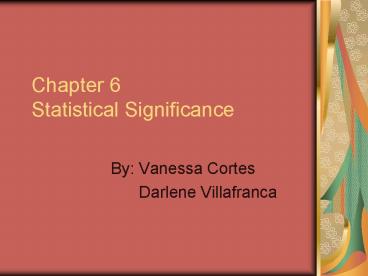Chapter 6 Statistical Significance PowerPoint PPT Presentation
1 / 19
Title: Chapter 6 Statistical Significance
1
Chapter 6Statistical Significance
- By Vanessa Cortes
- Darlene Villafranca
2
Significant means reliable not important
- In normal English, "significant" means important,
while in Statistics "significant" means probably
true (not due to chance). - A research finding may be true without being
important. - When statisticians say a result is "highly
significant" they mean it is very probably true. - They do not (necessarily) mean it is highly
important.
3
Statistics vs. Parameters
- Characterized aspects of data that constitute a
sample Statistics - Characterized features of data that constitute a
populationParameters - Researchers want to know if the sampling
descriptive statistics accurately approximates
population parameters
4
Three types of Significance
- Statistical Significance
- Practical Significance
- Clinical Significance
- All require calculations
- All yield numerical results
5
Statistical Significance Inferential Statistics
- Inferential Statistics are often the next step
after you have collected summarized data - Inferential statistics are used to make
inferences from smaller group of data to possibly
larger one - Inferential statistics are used to infer
something about the population based on the
samples characteristics
6
Null Hypothesis
- Null is always a statement of equality
- Null can be true or false
- No difference or truly is an inequality
- Null applies ONLY to the population
- The researcher never really knows the Null
hypothesis and if there is or is not a difference
between groups - WHY?
7
Hypothesis Testing
- You cannot make both Type I and Type II Error on
a given hypothesis - Once you reject, you could not have made a Type
II error. - Once you fail to reject, you could not have made
Type I error. - Hypotheses predicting zero differences or zero
relationship
8
Accept or Reject the Null Hypothesis
9
Statistical Power
- The power of a statistical test is the
probability that the test will reject a false
null hypothesis (that it will not make a Type II
error). As power increases, the chances of a Type
II error decrease, and vice versa. The
probability of a Type II error is referred to as
ß. Therefore power is equal to 1 - ß.
10
One-Tailed and Two-Tailed Significance Tests
- One important concept in significance testing is
whether you use a one-tailed or two-tailed test
of significance. The answer is that it depends on
your hypothesis. When your research hypothesis
states the direction of the difference or
relationship, then you use a one-tailed
probability. For example, a one-tailed test would
be used to test these null hypotheses Females
will not score significantly higher than males on
an IQ test. Blue collar workers are will not buy
significantly more product than white collar
workers. Superman is not significantly stronger
than the average person. In each case, the null
hypothesis (indirectly) predicts the direction of
the difference.
11
Two-Tailed Significance Tests
- A two-tailed test would be used to test these
null hypotheses There will be no significant
difference in IQ scores between males and
females. There will be no significant difference
in the amount of product purchased between blue
collar and white collar workers. There is no
significant difference in strength between
Superman and the average person. The one-tailed
probability is exactly half the value of the
two-tailed probability.
12
Properties of Sampling Distributions
- For all sampling distributions, the standard
deviation of the sampling distribution gets
smaller as sample size increases. - The mean of the statistics in a sampling
distribution for unbiased estimators will equal
the population parameter being estimated
13
Standard Error/Sampling Error
- Standard deviation of the sampling
distributionStandard error of the statistic or
Standard error. (SE)
14
Inferentially
- Statistical significance test is to divide the
statistic by its standard error. - 3 synonymous names for the fundamental ratio
- 1. t statistic
- 2. critical ratio
- 3. Wald statistic
15
Test Statistics
- Test statisticsstandardized sampling
distributions - Test statistics (TS) distributions can be used in
place of P values . - The comparison of a given P calculated with a
given PCRITICAL will always yield the same
decision about the comparison of a given TS
calculated with a given TSCRITICAL.
16
P calculated
- P calculated is calculating the estimated
probability - P values range from 0 to 1
- or 0 to 100
17
Procedure Used to Test for Significance
- Whenever we perform a significance test, it
involves comparing a test value that we have
calculated to some critical value for the
statistic. It doesn't matter what type of
statistic we are calculating (e.g., a
t-statistic, a chi-square statistic, an
F-statistic, etc.), the procedure to test for
significance is the same. - 1. Decide on the critical alpha level you will
use (i.e., the error rate you are willing to
accept). - 2. Conduct the research.
- 3. Calculate the statistic.
- 4. Compare the statistic to a critical value
obtained from a table.
18
If your statistic is higher than the critical
value from the table
- Your finding is significant.
- You reject the null hypothesis.
- The probability is small that the difference or
relationship happened by chance, and p is less
than the critical alpha level (p lt alpha ).
19
If your statistic is lower than the critical
value from the table
- Your finding is not significant.
- You fail to reject the null hypothesis.
- The probability is high that the difference or
relationship happened by chance, and p is greater
than the critical alpha level (p gt alpha ).

